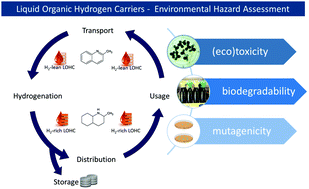当前位置:
X-MOL 学术
›
Energy Environ. Sci.
›
论文详情
Our official English website, www.x-mol.net, welcomes your
feedback! (Note: you will need to create a separate account there.)
Hazard assessment of quinaldine-, alkylcarbazole-, benzene- and toluene-based liquid organic hydrogen carrier (LOHCs) systems†
Energy & Environmental Science ( IF 32.4 ) Pub Date : 2018-12-06 00:00:00 , DOI: 10.1039/c8ee01696h Marta Markiewicz 1, 2, 3, 4, 5 , Ya-Qi Zhang 1, 2, 3, 4, 5 , Michael T. Empl 4, 6, 7, 8 , Marianna Lykaki 1, 2, 3, 4, 5 , Jorg Thöming 1, 2, 3, 4 , Pablo Steinberg 4, 6, 7, 8 , Stefan Stolte 1, 2, 3, 4, 5
Energy & Environmental Science ( IF 32.4 ) Pub Date : 2018-12-06 00:00:00 , DOI: 10.1039/c8ee01696h Marta Markiewicz 1, 2, 3, 4, 5 , Ya-Qi Zhang 1, 2, 3, 4, 5 , Michael T. Empl 4, 6, 7, 8 , Marianna Lykaki 1, 2, 3, 4, 5 , Jorg Thöming 1, 2, 3, 4 , Pablo Steinberg 4, 6, 7, 8 , Stefan Stolte 1, 2, 3, 4, 5
Affiliation

|
Due to the finite nature and scarcity of crude oil-based fuels, increasing attention is being directed towards various forms of renewable energy. To obtain a fully functional renewable energy system, some compensation for the spatiotemporal fluctuations in renewable energy sources is necessary. In this context, the so-called liquid organic hydrogen carrier (LOHC) systems are promising from a technological perspective, although their impact on the environment and on animal/human health has not been considered in great detail. Hence, we present a proactive, comparative environmental hazard assessment of LOHC systems based on three alkylcarbazoles and quinaldine, including H2-rich, H2-lean and intermediate (i.e., partially hydrogenated) forms as well as on benzene and toluene, also including H2-rich forms (cyclohexane and methylcyclohexane, respectively). Specifically, the present study reports on the enzyme inhibitory (acetylcholinesterase), mutagenic (Ames test) and cytotoxic (IPC-81 cell line) activities of the above-mentioned compounds. Furthermore, the aquatic toxicity of the test compounds to marine bacteria (Vibrio fischeri), green algae (Raphidocelis subcapitata), aquatic plants (Lemna minor) and water fleas (Daphnia magna) was assessed in addition to their biodegradability, using inocula from a wastewater treatment plant. To complete the picture, we compared the effects of the LOHCs investigated herein with those of diesel oil. In this context, our results suggest that the quinaldine-based LOHC system is comparable with diesel oil in terms of ecotoxicity but is less biodegradable. The alkylcarbazoles appear to be more toxic and poorly biodegradable. Lastly, the benzene and toluene-based LOHC systems give serious reasons for concern in terms of human and aquatic toxicity. Nevertheless, due to their less complex composition, the assessment of the LOHC systems carries much lower levels of uncertainty regarding adverse effects. Additionally, because of more favourable physicochemical properties (e.g., higher boiling points), some LOHCs are safer for handling and transportation. Finally, the possibility of storing and using renewable energy offers a significant environmental and economic benefit.
中文翻译:

奎纳丁,烷基咔唑,苯和甲苯基液态有机氢载体(LOHCs)系统的危害评估†
由于基于原油的燃料的有限性和稀缺性,人们越来越关注各种形式的可再生能源。为了获得功能齐全的可再生能源系统,必须对可再生能源的时空波动进行一定程度的补偿。在这方面,从技术角度看,所谓的液态有机氢载体(LOHC)系统是有前途的,尽管尚未详细考虑它们对环境和对动物/人类健康的影响。因此,我们提出了一个主动,基于三个alkylcarbazoles和喹哪啶,含H的LOHC系统的对比环境危害评估2富,H 2贫乏和中间(即,部分氢化)形式以及在苯和甲苯上的形式,也包括富含H 2的形式(分别为环己烷和甲基环己烷)。具体而言,本研究报告了上述化合物的酶抑制作用(乙酰胆碱酯酶),诱变作用(Ames试验)和细胞毒性作用(IPC-81细胞系)。此外,受试化合物对海洋细菌(Vibrio fischeri),绿藻(Raphidocelis subcapitata),水生植物(Lemna minor)和水蚤(Daphnia magna)的水生毒性。除使用了废水处理厂中的接种物外,还对其生物降解性进行了评估。为了使图片更完整,我们将本文研究的LOHC与柴油的效果进行了比较。在这种情况下,我们的结果表明,基于奎尼丁的LOHC系统在生态毒性方面可与柴油媲美,但生物降解性较低。烷基咔唑似乎更具毒性,且难生物降解。最后,基于苯和甲苯的LOHC系统给人和水生毒性带来了令人担忧的严重原因。但是,由于LOHC系统的组成不太复杂,因此对其不利影响的不确定性要低得多。此外,由于具有更好的理化特性(例如更高的沸点),某些LOHC更易于处理和运输。最后,储存和使用可再生能源的可能性提供了巨大的环境和经济利益。
更新日期:2018-12-06
中文翻译:

奎纳丁,烷基咔唑,苯和甲苯基液态有机氢载体(LOHCs)系统的危害评估†
由于基于原油的燃料的有限性和稀缺性,人们越来越关注各种形式的可再生能源。为了获得功能齐全的可再生能源系统,必须对可再生能源的时空波动进行一定程度的补偿。在这方面,从技术角度看,所谓的液态有机氢载体(LOHC)系统是有前途的,尽管尚未详细考虑它们对环境和对动物/人类健康的影响。因此,我们提出了一个主动,基于三个alkylcarbazoles和喹哪啶,含H的LOHC系统的对比环境危害评估2富,H 2贫乏和中间(即,部分氢化)形式以及在苯和甲苯上的形式,也包括富含H 2的形式(分别为环己烷和甲基环己烷)。具体而言,本研究报告了上述化合物的酶抑制作用(乙酰胆碱酯酶),诱变作用(Ames试验)和细胞毒性作用(IPC-81细胞系)。此外,受试化合物对海洋细菌(Vibrio fischeri),绿藻(Raphidocelis subcapitata),水生植物(Lemna minor)和水蚤(Daphnia magna)的水生毒性。除使用了废水处理厂中的接种物外,还对其生物降解性进行了评估。为了使图片更完整,我们将本文研究的LOHC与柴油的效果进行了比较。在这种情况下,我们的结果表明,基于奎尼丁的LOHC系统在生态毒性方面可与柴油媲美,但生物降解性较低。烷基咔唑似乎更具毒性,且难生物降解。最后,基于苯和甲苯的LOHC系统给人和水生毒性带来了令人担忧的严重原因。但是,由于LOHC系统的组成不太复杂,因此对其不利影响的不确定性要低得多。此外,由于具有更好的理化特性(例如更高的沸点),某些LOHC更易于处理和运输。最后,储存和使用可再生能源的可能性提供了巨大的环境和经济利益。











































 京公网安备 11010802027423号
京公网安备 11010802027423号